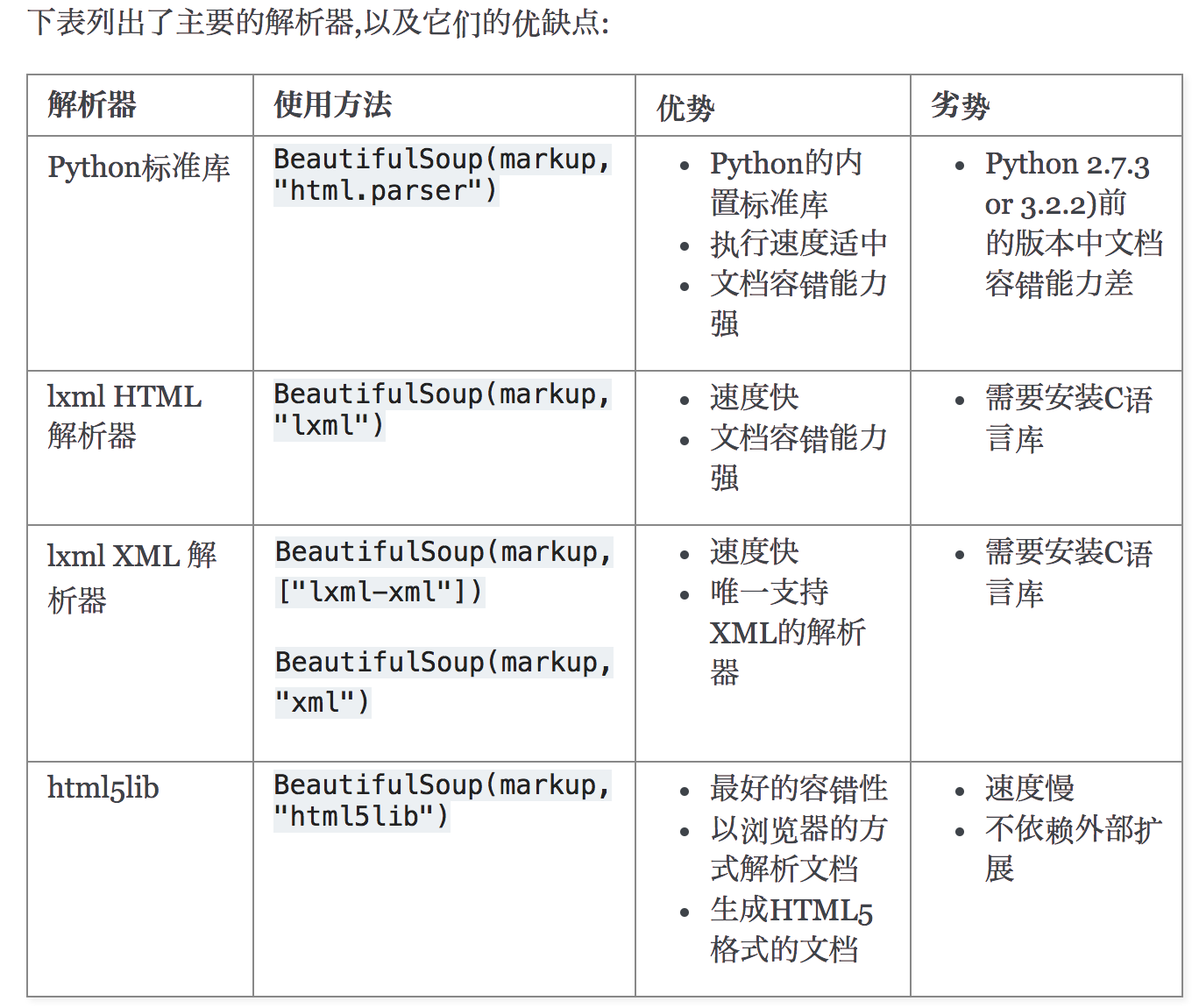BeautifulSoup
阅读目录
一 什么是BeautifulSoup
简单来说,Beautiful Soup是python的一个库,最主要的功能是从网页抓取数据。
官方解释如下:
Beautiful Soup提供一些简单的、python式的函数用来处理导航、搜索、修改分析树等功能。它是一个工具箱,通过解析文档为用户提供需要抓取的数据,因为简单,所以不需要多少代码就可以写出一个完整的应用程序。
Beautiful Soup 是一个可以从HTML或XML文件中提取数据的Python库。它能够通过你喜欢的转换器实现惯用的文档导航,查找,修改文档的方式。所以需要配合解析器一起使用!
Beautiful Soup会帮你节省数小时甚至数天的工作时间.你可能在寻找 Beautiful Soup3 的文档,Beautiful Soup 3 目前已经停止开发,官网推荐在现在的项目中使用Beautiful Soup 4。
解析器:
Beautiful Soup支持Python标准库中的HTML解析器,还支持一些第三方的解析器,如果我们不安装它,则 Python 会使用 Python默认的解析器,lxml 解析器更加强大,速度更快,推荐安装另一个可供选择的解析器是纯Python实现的 html5lib , html5lib的解析方式与浏览器相同。
解析器对比: 官方文档

# 安装 Beautiful Soup pip3 install beautifulsoup4 #安装解析器 ''' Beautiful Soup支持Python标准库中的HTML解析器,还支持一些第三方的解析器,其中一个是 lxml .根据操作系统不同,可以选择下列方法来安装lxml: apt-get install Python-lxml pip3 install lxml 另一个可供选择的解析器是纯Python实现的 html5lib , html5lib的解析方式与浏览器相同,可以选择下列方法来安装html5lib: apt-get install Python-html5lib pip3 install html5lib '''
二 为什么要用BeautifulSoup?
BeautifulSoup能给我们提供一些列查找文档树的方法,使我们能快速定位到我们想要爬取的数据。我们再回想一下之前学的一个re模块,它可以全局查找我们想要的文本,从文本开头到结束开始匹配,然后通过贪婪匹配,再通过非贪婪匹配拿到需要的数据,整个过程是不是非常繁琐,而却搜索效率极低!
BeautifulSoup内既封装了re,还为我们提供了一些更加强大、高效的功能,使我们可以快速匹配到我们想要的数据,提高爬取效率和开发效率。
三 安装
1、安装
# 安装BeautifulSoup4 pip3 install beautifulsoup4 # 安装解析器 # 根据官网解释,推荐使用lxml pip3 install lxml
四 怎么使用
1、基本使用
注意: 如何初始文本内有换行,也会算在里面。(坑)
html_doc = """ <html><head><title>The Dormouse's story</title></head> <body> <p class="sister"><b>$37</b></p> <p class="story" id="p">Once upon a time there were three little sisters; and their names were <a href="http://example.com/elsie" class="sister" >Elsie</a>, <a href="http://example.com/lacie" class="sister" id="link2">Lacie</a> and <a href="http://example.com/tillie" class="sister" id="link3">Tillie</a>; and they lived at the bottom of a well.</p> <p class="story">...</p> """ from bs4 import BeautifulSoup # 第一个参数是解析文本 # 第二个参数是解析器 soup = BeautifulSoup(html_doc, 'lxml') # 具备自动补全html标签功能 print(soup) # 美化html便签 html_doc = soup.prettify() print(html_doc)
2、遍历文档树
''' 1、直接使用 2、获取标签的名称 3、获取标签的属性 4、获取标签的内容 5、嵌套选择 6、子节点、子孙节点 7、父节点、祖先节点 8、兄弟节点 '''

from bs4 import BeautifulSoup # 注意: 如何初始文本内有换行,也会算在里面。(坑) html_doc = """ <html><head><title>The Dormouse's story</title></head><body><p class="sister"><b>$37</b></p><p class="story" id="p">Once upon a time there were three little sisters; and their names were<a href="http://example.com/elsie" class="sister" >Elsie</a><a href="http://example.com/lacie" class="sister" id="link2">Lacie</a> and<a href="http://example.com/tillie" class="sister" id="link3">Tillie</a>and they lived at the bottom of a well.</p><p class="story">...</p> """ # 第一个参数是解析文本 # 第二个参数是解析器 soup = BeautifulSoup(html_doc, 'lxml') # 具备自动补全html标签功能 # print(soup) # 美化html便签 html_doc = soup.prettify() # print(html_doc) # soup = BeautifulSoup(html_doc, 'lxml') # 1、直接选择标签(返回的是一个对象) print(soup.a) # 获取第一个a标签 print(soup.p) # 获取第一个p标签 print(type(soup.a)) # <class 'bs4.element.Tag'> # 2、获取标签的名称 print(soup.a.name) # 获取a标签的名字 # 3、获取标签的属性 print(soup.a.attrs) # 获取a标签内所有的属性 # 4、获取标签的内容 print(soup.a.attrs['href']) # 获取a标签内的href属性 # 5、嵌套选择标签 print(soup.p.b) # 获取第一个p标签内的b标签 print(soup.p.b.text) # 打印b标签内的文本 # 6、子节点、子孙节点 # 获取子节点 print(soup.p.children) # 获取第一个p标签所有的子节点,返回的是一个迭代器 print(list(soup.p.children)) # list转成列表 # 获取子孙节点 print(soup.body.descendants) # 获取body标签内所有的子孙节点,返回的是一个生成器 print(list(soup.body.descendants)) # list转成列表 # 获取第一个p标签中所有的内容,返回的是一个列表 print(soup.p.contents) # 7、父节点、祖先节点 # 获取父节点 print(soup.a.parent) # 获取第一个a标签内的父节点 # 获取祖先节点(爸爸,爸爸的爸爸,爸爸的爸爸的爸爸...以此类推) print(list(soup.a.parents)) # 获取第一个a标签的祖先节点,返回的是一个生成器 print('*' * 1000) # 8、兄弟节点 (sibling: 兄弟姐妹) print(soup.a) # 获取下一个兄弟节点 print(soup.a.next_sibling) # 获取下一个的所有兄弟节点,返回的是一个生成器 print(soup.a.next_siblings) print(list(soup.a.next_siblings)) # 获取上一个兄弟节点 print(soup.a.previous_sibling) # 获取上一个的所有兄弟节点,返回的是一个生成器 print(list(soup.a.previous_siblings))
3、搜索文档树
BeautifulSoup定义了很多搜索方法,这里着重介绍2个:find() 和 find_all() 。其它方法的参数和用法类似!
''' 标签查找与属性查找: 标签: - 字符串过滤器 字符串全局匹配 name 属性匹配 attrs 属性查找匹配 text 文本匹配 - 正则过滤器 re模块匹配 - 列表过滤器 列表内的数据匹配 - bool过滤器 True匹配 - 方法过滤器 用于一些要的属性以及不需要的属性查找。 属性: - class_ - id '''

from bs4 import BeautifulSoup import re # 注意: 如何初始文本内有换行,也会算在里面。(坑) html_doc = """ <html><head><title>The Dormouse's story</title></head><body><p class="sister"><b>$37</b></p><p class="story" id="p">Once upon a time there were three little sisters; and their names were<a href="http://example.com/elsie" class="sister" >Elsie</a><a href="http://example.com/lacie" class="sister" id="link2">Lacie</a> and<a href="http://example.com/tillie" class="sister" id="link3">Tillie</a>and they lived at the bottom of a well.</p><p class="story">...</p> """ # 第一个参数是解析文本 # 第二个参数是解析器 soup = BeautifulSoup(html_doc, 'lxml') ''' 标签查找与属性查找: 标签: - 字符串过滤器 字符串全局匹配 name 属性匹配 attrs 属性查找匹配 text 文本匹配 - 正则过滤器 re模块匹配 - 列表过滤器 列表内的数据匹配 - bool过滤器 True匹配 - 方法过滤器 用于一些要的属性以及不需要的属性查找。 属性: - class_ - id ''' # 1、字符串 # find的默认参数 第一个是name、第二个是attrs、第四个是text # name: 根据标签名匹配节点 print(soup.find('p')) # 获取第一个p标签 print(soup.find_all(name='p')) # 获取所有的p标签 # attrs: 根据属性查找匹配节点 print(soup.find(attrs={'id': 'p'})) # 查找id为p的标签 print(soup.find_all(attrs={'class': 'sister'})) # 查找class为sister的所有标签 # text: 根据文本匹配文档树内的文本 # 推荐配合其他匹配规则使用,否则毫无意义 print(soup.find(text='$37')) # 查找标签内为$37的文本 # name与text配合使用 print(soup.find_all(name='p', text='$37')) # 查找所有文本为$37的p标签 # name与attrs配合使用 print(soup.find(name='a', attrs={'id': 'link2'})) # 查找第一个id为link2的a标签 # attrs与text配合使用 print(soup.find_all(attrs={'id': 'link2'}, text='Lacie')) # 查找所有id为link2,文本为Lacie的标签 # name、attrs、text组合使用 print(soup.find_all(name='a', attrs={'id': 'link3'}, text='Tillie')) # 查找所有id为link3,文本为Tillie的a标签 # 2、正则 print(soup.find(name=re.compile('a'))) # 通过第一个标签名带有a的节点 print(soup.find_all(attrs={'id': re.compile('link')})) # 匹配所有id名带有link的节点 print(soup.find_all(text=re.compile('and'))) # 匹配所有文本带有"and"的节点 # 3、列表 (列表内可以匹配多个) print(soup.find_all(name=['a', re.compile('e')])) # 匹配所有a标签节点与所有标签中带有e的节点 print(soup.find_all(text=['$'])) # 找不到,因为$是精确查找 print(soup.find_all(text=['$37'])) # 查找$37文本,这样查找是没有意义的 print(soup.find_all(text=[re.compile('\$')])) # 正则中$是特殊字符,所以需要转义 # 4、bool print(soup.find_all(name=True)) # 查找所有有标签名的节点 print(soup.find_all(attrs={'id': True})) # 查找所有有id的节点 print(soup.find_all(text=True)) # 查找所有文本 # 5、方法 # 写一个只要有class没有id的a标签的函数 def has_class_not_id(arg): if arg.name == 'a' and arg.has_attr('class') and not arg.has_attr('id'): return arg.name print(soup.find_all(name=has_class_not_id)) # 通过has_class_not_id的函数匹配节点 # 6、标签与属性查找 # 标签 print(soup.find_all(attrs={'class': 'sister'})) # 属性 # 根据class属性查找,因为class是关键字,所以后面需要加下划线 print(soup.find_all(class_='sister')) # 根据id属性查找 print(soup.find_all(id='link2'))
五 自动登录抽屉新热榜并点赞与评论

''' # 抽屉新热榜自动登陆并点赞 1.需要携带评论主页的cookies信息去进行点赞,否则点赞失败 ''' from bs4 import BeautifulSoup import requests # 通过bs4解析库获取所有新闻的id for line in range(2, 4): index_url = 'https://dig.chouti.com/all/hot/recent/{0}'.format(line) response1 = requests.get(index_url, headers={ 'user-agent': 'Mozilla/5.0 (Windows NT 10.0; WOW64) AppleWebKit/537.36 (KHTML, like Gecko) Chrome/70.0.3538.77 Safari/537.36' } ) response1_cookies = response1.cookies soup = BeautifulSoup(response1.text, 'html.parser') items = soup.find_all(attrs={'class': 'item'}) # print(items) for item in items: div_tag = item.find(attrs={'class': 'part2'}) # print(div) # print(type(div)) # 拿到所有的id user_id = div_tag.get('share-linkid') # print(user_id) form_data = { "phone": "8615622792660", "password": "kermit46709394", "oneMonth": '1' } # print(url) response2 = requests.post('https://dig.chouti.com/login', headers={ 'user-agent': 'Mozilla/5.0 (Windows NT 10.0; WOW64) AppleWebKit/537.36 (KHTML, like Gecko) Chrome/70.0.3538.77 Safari/537.36' }, data=form_data, cookies=response1_cookies ) url = 'https://dig.chouti.com/link/vote?linksId={user_id}'.format(user_id=user_id) # 抽屉新热榜自动点赞 response3 = requests.post(url, headers={ 'user-agent': 'Mozilla/5.0 (Windows NT 10.0; WOW64) AppleWebKit/537.36 (KHTML, like Gecko) Chrome/70.0.3538.77 Safari/537.36' }, cookies=response1_cookies ) print(response3.text)





